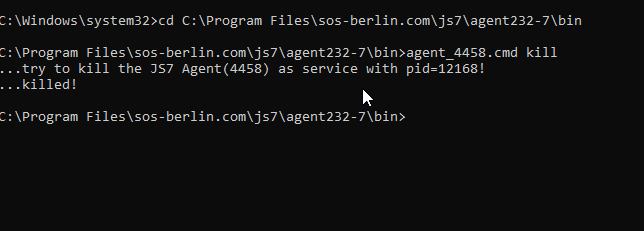Page History
| Table of Contents |
|---|
Introduction
The Agent Cluster is designed to provide horizontal scalability and fail-over capabilities for Agents in HA environments, see JS7 - Agent Cluster. It works without a single point of failure.
...
This article is focused on fail-over of Subagents. For fail-over scenarios with Director Agent Clusters see JS7 - How to test fail-over of Subagents in an Agent Cluster
For command line references see the JS7 - Agent - Command Line Operation article.
Fail-over Operation
Fail-over occurs when an Active Subagent is terminated abnormally. Fail-over includes that the task currently being executed by the Subagent is considered to have failed and that the related order is set to a failed state. An Inactive Subagent is no longer considered for execution of jobs by a Director Agent:
...
Fail-over happens within a short period of time, typically in 2-3s.
Round-robin Subagent Cluster
| Anchor | ||||
|---|---|---|---|---|
|
The JS7 - How to set up an Agent Cluster article explains how to set up a number of Subagents.
- Create a workflow from the Configuration view and assign the same Agent Cluster to all jobs. Once the configuration is completed deploy the workflow.
- The Agent Cluster is configured for round-robin scheduling and executes each subsequent job with the next Subagent.
- To test cluster behavior navigate to the Workflows view and select a workflow from the tree.
- Expand the workflow and add an order.
- Once the workflow has completed successfully open the log from the history panel.
- In the log, you can identify that all jobs use different Subagents as the Agent Cluster is set up for round-robin scheduling. Each next job is executed with the next Subagent.
Scenario for fail-over Cluster Operation
- Kill one of the Active Subagents from the command line to force fail-over with one of the below commands.
- An Active Subagent is killed, for example:
- on Unix with a SIGKILL signal corresponding to the command:
kill -9 - on Windows with the command:
taskkill /F
- on Unix with a SIGKILL signal corresponding to the command:
- From the command line, the Agent Instance Start Script can be used like this:
agent_<port>.sh | .cmd abortagent_<porr>.sh | .cmd kill
- An Active Subagent is killed, for example:
- Check the order log to verify that jobs in the workflow are successfully executed with all the remaining Subagents.
Fixed-priority Subagent Cluster
| Anchor | ||||
|---|---|---|---|---|
|
This scenario is similar to the Scenario for normal Cluster Operation of a round-robin Subagent Cluster with the exception that jobs are assigned a Subagent Cluster which is set up for fixed-priority scheduling.
Fixed-priority means that all jobs will be executed with the first Subagent unless it becomes unavailable and only then jobs will be executed with the next Subagent.
Scenario for fail-over Cluster Operation
- Kill the Active Subagent from the command line to force fail-over with one of the commands listed below.
- The Active Subagent is killed, for example:
- on Unix with a SIGKILL signal corresponding to the command:
kill -9 - on Windows with the command:
taskkill /F
- on Unix with a SIGKILL signal corresponding to the command:
- From the command line the Agent Instance Start Script can be used like this:
agent_<port>.sh | .cmd abortagent_<porr>.sh | .cmd kill
- The Active Subagent is killed, for example:
- Check the order log to verify that any jobs in the workflow are successfully executed with the next Subagent.
Further Resources
- JS7 - Agent Cluster
- JS7 - How to set up an Agent Cluster
- JS7 - Management of Agent Clusters
- JS7 - How to perform fail-over of Subagents in an Agent Cluster




